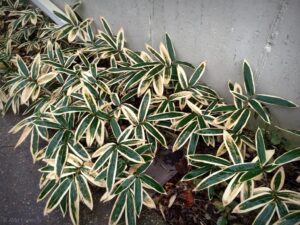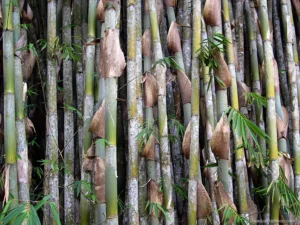
Bamboo is one of the most versatile and sustainable plants on Earth. Known for its strength, rapid growth, and environmental benefits, it plays a major role in modern sustainable development. From construction materials and furniture to textiles and paper, bamboo is helping industries move away from deforestation and non-renewable resources.
Often called the “green steel,” bamboo is both ancient and futuristic used in traditional craftsmanship for centuries, and now central to green architecture and eco-friendly design.
What Is Bamboo?
Bamboo belongs to the grass family Poaceae and is known for its hollow, jointed stems called culms. It grows in diverse climates, from tropical rainforests to mountain regions, across Asia, Africa, and South America.
Unlike trees, bamboo regenerates quickly after harvest because its underground rhizome system continues to grow. Some species can reach full maturity in just 3–5 years, making bamboo one of the fastest-renewing natural resources on the planet.
Major Types of Bamboo
There are more than 1,600 species of bamboo globally, but they are generally divided into two main categories based on how they spread: clumping and running bamboo.
1. Clumping Bamboo (Sympodial)
Clumping bamboos grow in tight clusters and spread slowly. They are ideal for landscaping, gardening, and building materials.
- Examples:
- Bambusa vulgaris – Common bamboo widely used for construction and scaffolding.
- Dendrocalamus asper – Giant bamboo native to Southeast Asia, used for furniture, flooring, and structural applications.
- Gigantochloa apus – Known as “string bamboo,” flexible and often used for weaving and crafts.
2. Running Bamboo (Monopodial)
Running bamboos spread rapidly through long underground rhizomes and can cover large areas. They are often used for reforestation, soil stabilization, and windbreaks.
- Examples:
- Phyllostachys edulis (Moso Bamboo) – Native to China; one of the most commercially important species used for flooring, paper, and bamboo textiles.
- Phyllostachys aurea (Golden Bamboo) – Known for its golden-colored culms and used for decorative and structural purposes.
- Sasa veitchii – A small Japanese bamboo commonly used for ornamental gardens.
Environmental Benefits of Bamboo
Rapid Growth and Renewability
Bamboo can grow up to one meter per day, making it one of the fastest-growing plants on Earth. Because it regenerates naturally, harvesting does not cause deforestation or permanent soil damage.
Carbon Sequestration
Bamboo absorbs more carbon dioxide (CO₂) and releases 35% more oxygen than equivalent stands of trees. It is a highly effective carbon sink and contributes significantly to climate change mitigation.
Soil and Water Protection
Bamboo roots form dense networks that prevent erosion, enhance soil stability, and restore degraded lands. It also helps maintain groundwater levels in regions prone to drought.
Economic and Practical Uses of Bamboo
1. Construction and Architecture
Bamboo’s tensile strength rivals steel, while its flexibility makes it ideal for earthquake-resistant buildings. It is used in:
- Housing structures
- Bridges and scaffolding
- Flooring and wall panels
- Roofing and interior design elements
Modern architects use bamboo to design eco-friendly resorts, schools, and community buildings that blend durability with natural beauty.
2. Furniture and Handicrafts
Bamboo furniture is lightweight, stylish, and environmentally friendly. It is widely used in chairs, tables, and decor. Traditional artisans also craft baskets, lamps, and other handmade products that support local economies.
3. Textiles and Paper
Processed bamboo fibers are used to make soft, breathable fabrics for clothing and linens. The pulp is also used to produce sustainable paper alternatives.
4. Food and Agriculture
Bamboo shoots are a nutritious food source rich in fiber, potassium, and vitamins. The leaves are also used as animal fodder, while bamboo groves support biodiversity and habitat conservation.
5. Energy and Industrial Uses
Bamboo charcoal and briquettes serve as renewable energy sources, offering cleaner alternatives to traditional wood fuel.
Bamboo and Sustainable Development
Bamboo aligns with multiple UN Sustainable Development Goals (SDGs), including:
- Goal 7 (Clean Energy): Used for biomass energy.
- Goal 11 (Sustainable Cities): Green building material for eco-architecture.
- Goal 13 (Climate Action): Reduces CO₂ emissions and supports reforestation.
- Goal 15 (Life on Land): Restores degraded land and conserves biodiversity.
By promoting bamboo cultivation and production, nations can create green jobs, reduce deforestation, and improve rural livelihoods.
Challenges in Bamboo Utilization
Despite its advantages, the bamboo industry faces certain challenges:
- Lack of international standardization and quality control for building applications.
- Limited industrial processing facilities in developing countries.
- Need for training and awareness among communities and construction professionals.
- Risks of invasive spread by some running bamboo species.
Addressing these challenges will allow bamboo to reach its full potential as a sustainable global resource.
Interesting Facts About Bamboo
- Bamboo can grow on every continent except Antarctica.
- The tensile strength of bamboo is approximately 28,000 psi, comparable to mild steel.
- Some bamboo species flower only once every 60–120 years.
- In many Asian cultures, bamboo symbolizes resilience, purity, and longevity.
Unique
Bamboo is more than just a plant it is a sustainable resource with the power to reshape industries and protect the planet. With over a thousand species adapted to diverse climates, bamboo offers endless possibilities for architecture, manufacturing, and environmental restoration.
By investing in bamboo research, cultivation, and innovation, the world can take a significant step toward a greener, more sustainable future.






